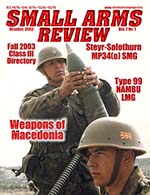By Finn Neilsen
The period between the first and Second World War was a most interesting one in the field of small arms development. This period saw the transition from the expensively made-from-solid firearm to the cheap, yet just as effective, made-from-stampings firearm. This was particularly the case with submachine guns, the German MP40 being one of the early examples. The MP40 really bridged the gap between the first and second generations of submachine guns.
The first generation of submachine guns can be characterized as weapons which used machined receivers, wood stocks (often fine walnut), and rifle-type rear sights. They include the MP18 I, MP28 II, Erma EMP, Bergmann MP35, Thompson 1921, 1928, Suomi 1926 and 1931 and a multitude of others in various European countries.
The second generation includes the MP40, various marks of Stens, Madsen 50 and 53 and the American M3, among others. The production quality of this generation is considerably lower than those of the first, although there is usually no change is reliability.
Third generation submachine guns will include any with “telescoping bolt” systems, such as the Czech Vz25/26 series and their Israeli copies; and usually incorporate the extensive use of polymers in their larger parts such as stocks (such as the Austrian Steyr MPi69).
In terms of dates we can put them approximately as follows:
•1st Generation: 1917 - 1940
•2nd Generation: 1940 - 1960
•3rd Generation: 1960 - to the present
Naturally there is some overlap with the various models in different countries and this is a rule-of-thumb only. Now that that has been put into perspective let us look at the subject of this article, the ZK383/Vz9.
The Germans annexed Czechoslovakia in 1938 as a result of the gutless caving in to Hitler’s demands by the French and British. Czechoslovakia was created out the mess following World War 1. It became a republic in 1920 and shed the authority of the Austro-Hungarian Empire. The legendary Skoda works, founded in 1869 by Emil Skoda produced most of the weapons the Czechs made for own use, and export. Czech artillery and small arms were of a quality unsurpassed in the world. By the time of the annexation, a healthy export sales programme was in place. Many third world countries armies used rifles and light machineguns made in Pilsen. In fact most of the Waffen SS’s early light armament consisted of excellent Vz24 (a derivative of the ’98 Mauser), not to mention the Bren predecessor, the ZBVz26 series of light machinegun. They gave the Germans and Belgians plenty of competition in the world market of firearms.
The ZK383 is a typical second generation submachinegun. The only stampings in it are in its unique bipod which folds to fit into the forearm. Typical of this generation it was made of the finest materials with fit and finish easily rivaling some of today’s sporting rifles. It was designed by Josef and Frantisek Koucky at the Zbrojovka Brno plant, where it remained in limited production from the late 1930s until about 1948.
The example which I own is a post-war sample made for Venezuela. It is marked with that countries coat-of-arms as well as the legend “FUERZAS ARMADAS MILITARES, VENEZUELA” (Military Armed Forces of Venezuela).
It is of 9x19mm Parabellum caliber and fitted with a 30-round magazine which is housed on the left side of the receiver at a slightly upward angle. The magazine is a two-position-feed, staggered-column, detachable box-type. The magazine release lever is at the rear of the magazine-well facing the shooter. It is a sturdy lever, easily pushed to release the magazine. Overall length is 35.4 inches (875 mm), with a barrel length of 12.8 inches (325 mm). The six-groove barrel has a right-hand twist. The weight, empty is 9.37 pounds (4.25 kg) - typical of submachine guns of this era and generation. The front sight is a protected blade-type and the tangent-type rear sight features an open V-notch, which is adjustable in 100-meter increments from 100 to 800 meters.
It is a selective-fire weapon, firing from an open bolt, with the selector found at the left rear just behind the small cocking handle. The position marked “30” indicates full-auto, with “1” indicating semiautomatic. A cross bolt safety is found above the trigger which blocks its rearward travel when applied.
Its internal features are quite interesting. The return spring for the bolt is housed in the buttstock, a feature similar to the Austrian Steyr-Solothurn SMG and also the much later FN FAL and H&K G3 series of rifles.
Disassembly is simple. Merely place the selector in the 90-degree position and pull it out to the left. The weapon may now be broken open and the bolt unit with its attached “rat tail” pulled back and out of the receiver. Pull back on the catch behind the rear sight and pull and turn the barrel out of the weapon. Replace in reverse order. Looking at the bolt you will note that there is a piece of metal fitted into the bolt body which can be readily removed. This is a rate of fire reducer/increaser, depending on whether or not it is installed into the bolt body. Theoretical rate of fire with the weight is 500 rpm and without it is 700 rpm, about the same as an original S & W M76.
The ZK383 was also fielded by the Waffen SS, who apparently used just about anything the Wehrmacht didn’t want! Theirs were marked “Vz9” and made under German supervision.
Given its length, weight and caliber, the ZK383 is a pleasure to shoot. I have used mine in our club shoots with some success. The bipod helps of course, but they won’t let me use it!
This article first appeared in Small Arms Review V7N1 (October 2003) |
| SUBSCRIBER COMMENT AREA |
Comments have not been generated for this article.








